Amstrad
This articleneeds additional citations forverification.(December 2010) |
 Sugar Towerin Brentwood, England (pictured in 2005) | |
| Amstrad | |
| Formerly |
|
| Company type |
|
| Industry | Electronics |
| Founded | 1 November 1968[2](original company) |
| Founder | Alan Sugar |
| Defunct | 2011 |
| Fate | Acquired bySky(2007) |
| Headquarters | Kings Road,Brentwood, Essex,United Kingdom |
Area served | UK and Ireland |
| Revenue | |
Number of employees | 85 (2005) |
| Website | amstradat theWayback Machine(archived January 25, 2019) |
Amstradwas a Britishconsumer electronicscompany, founded in 1968 byAlan Sugar.During the 1980s, the company was known for itshome computersbeginning with theAmstrad CPCand later also theZX Spectrumrange after theSinclairdeal, which led it to have a substantial share of the PC market in Britain. In the following decade it shifted focus towards communication technologies,[3]and its main business during the 2000s was the manufacture ofsatellite televisionset-top boxes forSky,[4]which Amstrad had started in 1989 as the then sole supplier of the emerging Sky TV service.[5]
Headquartered inBrentwood,the company was listed on theLondon Stock Exchangefrom 1980 to 2008, the year when Sugar stepped down after 40 years.[6]After acquiringBetacomandViglen,Amstrad was broken up in 1997 but the name was soon revived when successor Betacom plc renamed itself to Amstrad plc.[7]Amstrad was aFTSE 100 Indexconstituent up until the company was acquired byBSkyBin 2007 for £125 million.[4]In 2010, Sky integrated Amstrad's satellite division as part of Sky so they could make their own set-top boxes in-house.
History[edit]
Early beginnings[edit]
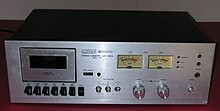
Amstrad (also known as AMSTrad) was founded in 1968 byAlan Sugarat the age of 21, the name of the original company being AMS Trading (Amstrad) Limited, derived from its founder's initials (Alan Michael Sugar). Amstrad entered the market in the field ofconsumer electronics.During the 1970s they were at the forefront of low-priced hi-fi, TV and car stereocassettetechnologies. Lower prices were achieved byinjection mouldingplastic hi-fi turntable covers, undercutting competitors who used thevacuum formingprocess.
Amstrad expanded to the marketing of low costamplifiersandtuners,imported fromEast Asiaand badged with the Amstrad name for the UK market. Their first electrical product was the Amstrad 8000 amplifier.
Home computers[edit]

In 1980, Amstrad went public trading on theLondon Stock Exchange,and doubled in size each year during the early '80s. Amstrad began marketing its ownhome computersin an attempt to capture the market fromCommodoreandSinclair,with theAmstrad CPCrange in 1984. The CPC 464 was launched in the UK, Ireland, France, Australia, New Zealand, Germany, Spain and Italy. It was followed by the CPC 664 and CPC 6128 models. Later "Plus" variants of the 464 and 6128, launched in 1990, increased their functionality slightly.
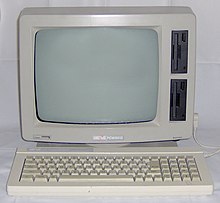
In 1985, the popularAmstrad PCWrange was introduced, which were principallyword processors,complete with printer, running theLocoScriptword processing program. They were also capable of running theCP/Moperating system. TheAmsoftdivision of Amstrad was set up to provide in-house software and consumables.
On 7 April 1986 Amstrad announced it had bought from Sinclair Research "the worldwide rights to sell and manufacture all existing and future Sinclair computers and computer products, together with the Sinclair brand name and those intellectual property rights where they relate to computers and computer related products",[8]which included theZX Spectrum,for £5 million. This included Sinclair's unsold stock ofSinclair QLsand Spectrums. Amstrad made more than £5 million on selling these surplus machines alone. Amstrad launched two new variants of the Spectrum: the ZX Spectrum +2, based on the ZX Spectrum 128, with a built-incassette tape drive(like the CPC 464) and, the following year, the ZX Spectrum +3, with a built-infloppy diskdrive (similar to the CPC 664 and 6128), taking the 3 "disks that many Amstrad machines used.

In 1986 Amstrad entered theIBM PC-compatiblearena with thePC1512system. In standard Amstrad livery and priced at £399 it was a success, capturing more than 25% of the European computer market.[citation needed]It wasMS-DOS-based, but with the GEM graphics interface, and laterWindows.In 1988 Amstrad attempted to make the first affordable portable personal computer with thePPC512 and 640models, introduced a year before theMacintosh Portable.They ranMS-DOSon an 8 MHz processor, and the built-in screen could emulate theMonochrome Display AdapterorColor Graphics Adapter.Amstrad's final (and ill-fated) attempts to exploit the Sinclair brand were based on the company's own PCs; a compact desktop PC derived from the PPC 512, branded as theSinclair PC200,and the PC1512 rebadged as the Sinclair PC500.

Amstrad's second generation of PCs, the PC2000 series, were launched in 1989. However, due to a problem with theSeagateST277R hard disk shipped with the PC2386 model, these had to be recalled and fitted withWestern Digitalcontrollers. Amstrad later successfully sued Seagate, but following bad press over the hard disk problems, Amstrad lost its lead in the European PC market.[9]
Launch of Sky and Astra Satellite[edit]

Amstrad had been a major supplier ofset top boxesto UKsatellite televisionpay-TV providerSkysince its launch in 1989 following the launch of the SESAstra 1ATV satellite. Amstrad was key to the introduction of Sky, as the company was responsible for finding methods to produce the requisite equipment at an attractive price for the consumer - Alan Sugar famously approached "someone who bashes out dustbin lids", to manufacture meshsatellite dishescheaply. Ultimately, it was the only manufacturer producing receiver boxes and dishes at the system's launch, and continued to manufacture set top boxes for Sky, from analogue to digital including Sky'sSky+digital video recorder.
With the addition of theAstra 1BTV satellite in May 1991 even more TV programs were available in Central Europe. In former East Germany as well as in the parts of former West Germany that had no access to cable TV, the affordable Amstrad receiver with the typical black mesh minidish were sold in large numbers.
Restructuring in the 1990s[edit]

In the early 1990s, Amstrad began to focus on portable computers rather thandesktop computers.In 1990, Amstrad tried to enter thevideo game consolemarket with theAmstrad GX4000,similar to whatCommodoredid at the same time with theC64 GS.The console, based on the Amstrad 464 Plus hardware, was a commercial failure, because it used outdated technology, and most games available for it were straight ports of CPC games that could be purchased for much less in their original format.

In 1993, Amstrad was licensed bySegato produce a system which was similar to theSega TeraDrive,going by the name of theAmstrad Mega PC,to try to regain their image in the gaming market. The system didn't succeed as well as expected, mostly due to its high initial retail price of £999. In that same year, Amstrad released thePenPad,aPDAsimilar to theApple Newton,and released only weeks before it. It was a commercial failure, and had several technical and usability problems. It lacked most features that the Apple Newton included, but had a lower price at $450.

As Amstrad began to concentrate less on computers and more in communication, they purchased several telecommunications businesses includingBetacom,Dancall Telecom,Viglen Computers,and modem manufacturer Dataflex Design Communications, bought out of liquidation, during the early 1990s. The company also established a direct marketing channel, Amstrad Direct, in late 1994 and announced 486- and Pentium-based products including an "All-in-OneMultimedia PC "with built-in television tuner, infra-red remote control, amplifier and speakers. A pen-based personal digital assistant with support for a PCMCIA-based modem, the InfoPad, was also unveiled with a September 1995 launch scheduled.[10]
By 1996, Alan Sugar was reported as having been looking for a buyer for Amstrad "for some time". Amongst the group's assets, cumulatively valued at£200 million,the Dancall subsidiary was of particular interest to potential acquirerPsion,producer of handheld computer products, for its expertise in "GSM digital mobile phone functionality" and the potential to integrate such functionality into Psion's own product range. Despite "long drawn out negotiations", the parties failed to agree a price and a strategy to dispose of the group's other assets.[11]In 1997, Amstrad PLC was wound up, its shares being split into Viglen and Betacom instead. Betacom PLC was then renamed Amstrad PLC.
The same year, Amstrad supplied set top boxes to Australian broadcasterFoxtel,and in 2004 to Italian broadcasterSky Italia.

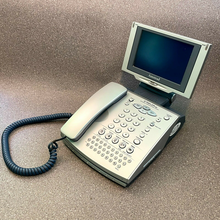
E-m@iler, Sky boxes, and final years[edit]
In 2000, Amstrad released the first of its combinedtelephonyandemaildevices, called theE-m@iler.This was followed by theE-m@iler Plusin 2002, and theE3 Videophonein 2004. Amstrad's UK E-m@iler business is operated through a separate company, Amserve Ltd which is 89.8% owned by Amstrad and 10.2% owned byDSG International plc(formerlyDixonsplc).
Amstrad has also produced a variety of home entertainment products over their history, including hi-fi, televisions,VCRs,andDVDplayers.
BSkyB takeover[edit]
In July 2007,British Sky Broadcasting (BSkyB)announced a takeover of Amstrad for £125m,[12]a 23.7% premium on its market capitalisation. BSkyB had been a major client of Amstrad, accounting for 75% of sales for its 'set top box' business. Having supplied BSkyB with hardware since its inception in 1988, market analysts had noted the two companies becoming increasingly close.
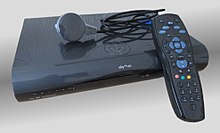
Sky bought Amstrad so they could have their own hardware development division to develop new satellite boxes (Sky Q) made in-house.[13]Under Sky, Amstrad only produced satellite receivers for Sky, as doing so allows them to reduce costs by cutting out the middleman.[14]Its main competitor in this space wasPace plc.[4]
Sugar commented that he wished to play a part in the business, saying: "I turn 60 this year and I have had 40 years of hustling in the business, but now I have to start thinking about my team of loyal staff, many of whom have been with me for many years."
It was announced on 2 July 2008 that Sugar had stepped down as Chairman of Amstrad, which had been planned since BSkyB took over in 2007. Amstrad was taken off the Stock Exchange on 9 October 2008.[15][16][17]Amstrad has ceased operations as a trading company, and now exists in name only.[18]Amstrad's former offices are now aPremier InnHotel.[19]
Computer product lines[edit]
Home computers[edit]
- CPC 464(64KBRAM, cassette drive)
- CPC 472(same as CPC 464 but with 72 KB instead of 64 KB)
- CPC 664(3 inch internal disk variant of CPC 464)
- CPC 6128(128 KB version of the CPC 664 with 3 inch disk)
- 464 plus(CPC 464 with enhanced graphics and sound)
- 6128 plus(CPC 6128 with enhanced graphics and sound)
- GX4000(games console based on 464 plus)
- SinclairZX Spectrum +2(re-engineeredZX Spectrum 128with tape drive)
- SinclairZX Spectrum +3(as ZX Spectrum +2 but with 3 inch disk drive instead of tape drive)
Word processors[edit]
- PCW8256(Z80,3.5 MHz, 256 KB RAM, single 180 KB 3 "floppy drive, dot-matrix printer, green screen)
- PCW8512(same as PCW8256 but with 512 KB RAM, 180 KB 3 "A: drive, 720 KB 3" B: drive)
- PCW9512(Z80, 3.5 MHz, 512 KB RAM, single or dual 720 KB 3 "floppy drives, daisywheel printer," paper white "screen)
- PcW9256(Z80, 3.5 MHz, 256 KB RAM, single 720 KB 3.5 "floppy drive, dot-matrix printer," paper white "screen)
- PcW9512+(same as PCW9512 but with single 3.5 "720 KB floppy drive)
- PcW10(same as PcW9256 but with 512 KB RAM and a built-in parallel port)
- PcW16(Z80, 16 MHz, single 1.44 MB 3.5 "floppy drive, new machine not directly compatible with old PCWs)
Notepad computers[edit]
- NC100(Z80, 64 KB RAM, 80×8 character LCD)
- NC150(NC100 with 128 KB RAM, floppy disk interface and NC200 firmware — sold in France and Italy)
- NC200(Z80, 128 KB RAM, adjustable 80×16 character LCD, 3.5 in floppy disk drive)
PC compatibles[edit]
- PC1512(Intel 8086,8 MHz, 512 KB RAM, enhancedCGAgraphics up to 640x200x16) - Marketed in the United States as the PC5120
- PC1640(Intel 8086, 8 MHz, 640 KB RAM,MDA/Hercules/CGA/EGAcolour graphics) - Marketed in the United States as the PC6400
- PPC512(Portable usingNEC V30processor, 512 KB RAM, non-backlitsupertwistCGA, one or two 720 KB 3.5 "floppy drives) - released around the same time as the PC1512.
- PPC640(Portable using NEC V30 processor, 640 KB RAM, non-backlit supertwist CGA, one or two 720 KB 3.5 "floppy drives, internalmodem) - released around the same time as the PC1640.
- Sinclair PC200(integral desktop PC for home computer market based on PPC512)
- PC-20the Australian and United States version of the Sinclair PC200 except that the United States version does not have a RF modulator.
- Sinclair PC500(rebadged PC1512)
- PC1286
- PC1386(Intel 80386SXCPU, 20 MHz, 1 MB RAM)
- PC2086(Intel 8086 CPU, 8 MHz, 640 KB RAM,VGAgraphics) launched 1989
- PC2286(Intel 80286CPU, 12.5 MHz, 1 MB RAM, VGA graphics) launched 1989
- PC2386(Intel 80386DXCPU, 20 MHz, 4 MB RAM, VGA graphics) launched 1989.
- PC3086( 8 MHz 8086 CPU, 640 KB RAM)
- PC3286(16 MHz 80286 CPU, 1 MB RAM)
- PC3386SX(20 MHz 80286SX CPU, 1 MB RAM)
- PC4386SX(20 MHz 80386SX CPU, 4 MB RAM)
- PC5086(8 MHz 8086 CPU, 640 KB RAM)
- PC5286(16 MHz 80286 CPU, 1 MB RAM)
- PC5386SX(20 MHz 80386SX CPU, 2 MB RAM, VGA graphics) launched 1991
- PC6486SX
- PC7000series: PC7286, PC7386SX, PC7486SLC
- PC8486
- PC9486(25 or 33 MHz 80486SX, or 50 MHz 80486DX2)
- PC9486i(66 MHz 80486DX2 CPU, 4 MB RAM)
- PC9555i(120 MHzPentium)
- Amstrad Mega PC(Intel 80386SX CPU, 25 MHz, IntegratedMega Drive)
- ALT286(laptop; 16 MHz 80286 CPU, 1 MB RAM)
- ALT386SX(laptop; 16 MHz 80386SX CPU, 1 MB RAM)
- ACL386SX(laptop; 20 MHz 80386SX CPU, 1 MB RAM, colourTFT LCD)
- ANB386SX(notebook; 80386SX CPU, 1 MB RAM)
PC accessories[edit]
- Amstrad DMP10009-pindot matrixprinter
- Amstrad DMP3000, DMP3160, DMP3250di9-pin dot matrix printer (different printing speed), the special model 3250di(dual interface) having both serial and parallel ports
- Amstrad SM24002400baudinternalmodem(came with Mirror software)
PDA[edit]
- PDA 600 Pen Pad(1993, Z8S180 CPU)
Set-top box[edit]
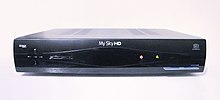
- Amstrad/Fidelity Satellite SystemsSRX100(1989),SRX200(1989),SRD400(1990)
- Amstrad Sky boxDRX100(2001),DRX200(2001),DRX300(2003),DRX400(2004),DRX500(2004),DRX550,(2006)
- Amstrad Sky+ boxDRX180(2003),DRX280(2003)
- Amstrad Sky+HD boxDRX780(2007),DRX890,DRX895(2009)
- Amstrad Sky HD Multiroom ReceiverDRX595(2011)
See also[edit]
References[edit]
- ^"Amstrad Company Profile".Archived fromthe originalon 12 January 2016.Retrieved10 January2016.
- ^"The Amstrad Times"(PDF).amshold.Retrieved25 February2024.
- ^"A Snapshot of British Computing".Google Arts & Culture.Retrieved16 February2024.
- ^abc"BSkyB agrees £125m Amstrad deal".31 July 2007.Retrieved16 February2024.
- ^Hughes, Donncha (30 May 2011)."A blogpost charting the role of Mr Alan Sugar in the success of Sky TV".Donncha Hughes, Business Trainer, Advisor & Mentor.Retrieved16 February2024.
- ^"Sir Alan steps down from Amstrad".2 July 2008.Retrieved16 February2024.
- ^"BETACOM DECIDES TO CALL ITSELF AMSTRAD - Tech Monitor".21 October 1997.Retrieved16 February2024.
- ^"CRASH 28 - News".Retrieved10 January2016.
- ^Computer Contracts - Merchantable Quality in Hardware Contracts - Amstrad plc v. Seagate Technology"Richard Cole Must Computer Contracts always be fit for Purpose".Archived from the original on 5 September 2008.Retrieved12 January2009.
{{cite web}}:CS1 maint: bot: original URL status unknown (link) - ^"'Sleeping giant' to reawake ".Computer Shopper.May 1995. p. 392.
- ^"Psion, StrongARM, GSM and the Amstrad factor".Acorn User.October 1996. p. 9.Retrieved29 August2021.
- ^"BSkyB agrees £125m Amstrad deal".BBC News.31 July 2007.Archivedfrom the original on 6 August 2007.Retrieved31 July2007.
- ^"End of an era as Sky buys Amstrad".IT PRO.31 July 2007.
- ^"End of an era as Sky buys Amstrad".IT PRO.31 July 2007.
- ^"PDF from Company House".
- ^"Sugar steps down as Amstrad Chairman".
- ^"Sir Alan steps down from Amstrad".BBC News.2 July 2008.Retrieved23 April2010.
- ^"Accounts for a dormant company".
- ^"Brentwood Hotels | Book Cheap Hotels In Brentwood Essex | Premier Inn".premierinn.
Further reading[edit]
- Sugar, Alan.What You See Is What You Get: My Autobiography(2010) hardbackISBN978-0-230-74933-7
- Thomas, David.Alan Sugar: The Amstrad Story(1991), paperbackISBN0-330-31900-0.
External links[edit]
- Amstrad
- Electronics companies established in 1968
- Home computer hardware companies
- Electronics companies of the United Kingdom
- Defunct computer companies of the United Kingdom
- Companies formerly listed on the London Stock Exchange
- Companies based in Brentwood, Essex
- 1968 establishments in England
- Defunct computer hardware companies
- Defunct computer systems companies
